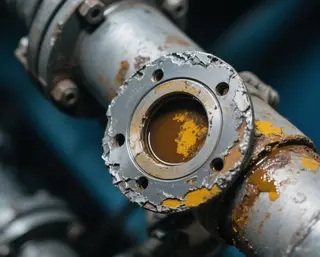Gasket Failure in Industrial Systems: Causes and Prevention Strategies
In industrial production, gaskets play a critical role in ensuring the sealing integrity of equipment and pipelines. However, under complex operating conditions, gaskets may fail due to mechanical, chemical, or thermal factors, leading to leakage, safety risks, and costly downtime.
This article analyzes the main causes of gasket failure and provides practical preventive measures to improve sealing reliability and extend gasket service life.
1. Common Causes of Gasket Failure
In equipment and pipeline systems, gasket failure is one of the leading causes of leakage and safety incidents. Understanding the root causes helps engineers design better systems and perform more effective maintenance.
(1) Pressure Changes and Compressive Forces
During operation, gaskets are subjected to continuous pressure and clamping forces. Excessive pressure or incorrect design may lead to plastic deformation, rupture, or blowout. In high-pressure applications, if the gasket material cannot handle the load, sealing failure is inevitable.
(2) Friction and Wear
Gaskets experience friction and shear stress against mating surfaces. Over time, this causes surface wear, allowing media to penetrate micro-channels and reduce sealing performance. In high-speed rotating equipment, friction-induced wear occurs even faster, leading to premature gasket failure.
(3) Vibration and Impact
Mechanical vibration and impact generate dynamic stresses that accelerate fatigue failure. In large rotating machinery or transport equipment, frequent vibration weakens the gasket’s elasticity, causing cracks or loss of sealing force.
(4) Flange Surface Shape and Roughness
The sealing performance depends heavily on surface finish and alignment.
- Metal gaskets require a smooth surface (Ra 6.3–3.2 µm), while soft gaskets tolerate Ra 25–12.5 µm.
- Scratches, burrs, corrosion, or old gasket residues prevent full contact and reduce tightness.
- Poor flatness or misalignment between flanges leads to uneven compression and early leakage.
(5) Unsuitable Gasket Material
Material properties determine a gasket’s ability to resist temperature, pressure, and chemical attack. A good gasket should have sufficient elasticity and plasticity, resist hardening or softening under temperature changes, and remain impermeable to the medium. If the material lacks flexibility or chemical compatibility, sealing failure occurs quickly.
(6) Chemical Corrosion
Exposure to corrosive media such as acids, alkalis, or salt solutions can deteriorate gasket materials. Inadequate chemical resistance leads to surface degradation, embrittlement, or complete disintegration.
(7) Thermal Expansion, Contraction, and Thermal Stress
Temperature fluctuations cause gaskets to expand and contract. Repeated thermal cycling produces thermal fatigue and loss of elasticity. At high temperatures, gaskets may loosen; at low temperatures, they may crack due to contraction.
(8) Cooling-Induced Leakage
During cooling, flanges and bolts contract at different rates, reducing clamping force and allowing leaks. For low-temperature systems, gaskets with low-temperature elasticity should be used, along with high-strength bolts and minimal flange gaps.
(9) Incorrect Installation Pressure
Improper tightening can destroy the gasket or reduce sealing force.
- Over-tightening leads to excessive compression and permanent deformation.
- Under-tightening results in insufficient clamping pressure and leakage.
(10) Improper Operation and Maintenance
Improper torque, uneven bolt tightening, or the use of incorrect tools can all lead to non-uniform stress distribution. In real installations, flange misalignment often introduces bending moments, creating uneven sealing pressure and promoting leakage under load.
(11) Stress Relaxation and Torque Loss
Over time, vibration, temperature changes, and material creep cause bolt tension loss and gasket stress relaxation, reducing sealing performance. Torque loss is more pronounced with short, thick bolts or large temperature fluctuations.
2. Measures to Prevent Gasket Failure
After identifying the main failure causes, effective preventive measures can be implemented to ensure long-term sealing reliability.
(1) Select Suitable Gasket Materials
Choose materials based on pressure, temperature, and medium characteristics.
- For corrosive or hazardous media, use high-temperature, high-pressure-resistant and chemically stable gaskets.
- Ensure compatibility with the medium to prevent swelling, embrittlement, or chemical attack.
(2) Ensure Proper Installation Quality
- Clean gasket and flange surfaces thoroughly before assembly.
- Check for scratches or irregularities on the sealing surface.
- Position the gasket correctly and tighten bolts gradually in a crosswise sequence using a torque wrench.
- Store non-metallic gaskets in dry, shaded areas and label them clearly with model, size, and specifications to prevent misuse.
(3) Control Temperature Fluctuations
To minimize thermal stress, select gaskets with stable elasticity across the operating temperature range. For low-temperature service, use thinner gaskets and smaller flange gaps to reduce stress concentration.
(4) Reduce Stress Relaxation and Torque Loss
- Use longer, thinner bolts to retain residual torque.
- Apply controlled heating and torque retention during installation to improve preload stability.
- Avoid excessive vibration, impacts, or striking of bolted joints after assembly.
(5) Perform Regular Inspection and Maintenance
- Inspect gasket condition periodically for aging, deformation, or corrosion.
- Replace damaged gaskets promptly.
- Check bolt tightness regularly and re-torque if necessary.
- Monitor flange alignment and equipment vibration to prevent secondary damage.
Conclusion
Gaskets are small but indispensable components in industrial sealing systems. Their failure can lead to severe leaks, safety incidents, and costly downtime.
By understanding failure mechanisms—including pressure overload, vibration, temperature variation, and improper installation—and by applying correct material selection, assembly practices, and regular maintenance, operators can significantly enhance gasket reliability and extend service life.
A systematic approach to gasket management not only ensures equipment safety but also improves operational efficiency and reduces maintenance costs across the entire plant. It's important to know about Google SEO to help your website rank higher in search results.





Comments